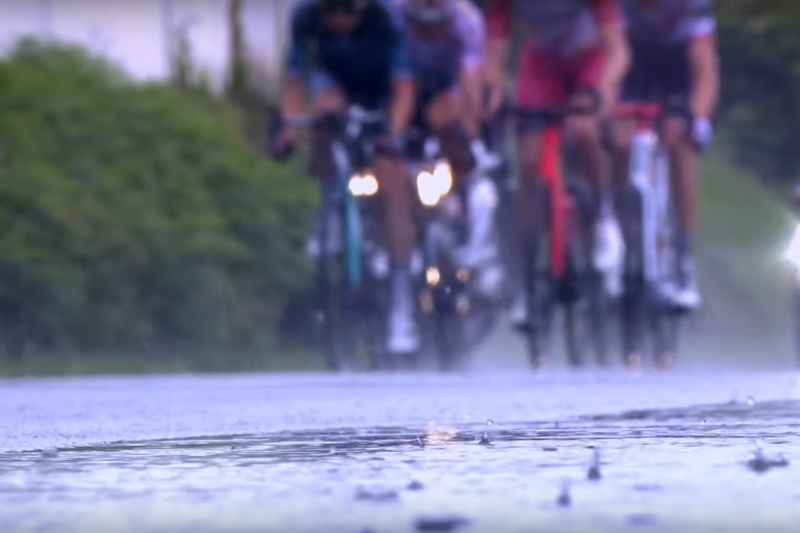
The first week of the Tour de France is not normally so much about the racing as what ensues as a result of the racing. I’m talking about crashes, basically.
In other races, you have a good few riders who are only really there to get fit. Throw in the fact that no-one gives a toss who wins the points jersey at the Tour du Limousin or wherever and you end up with a situation where there are only really so many people trying to get to the front at the end of any given day.
The Tour is different. The Tour is the main thing. Everyone is in top shape and everyone wants to be at the front and the road is only so wide.
The unpleasant truth is that early on, crashes shape the Tour de France.
And they’re off!
The 2020 Tour had featured unusually barren roadsides. What would the fan situation be like this year? With one facing-the-wrong-way roadside numbnuts, normal service was immediately resumed.
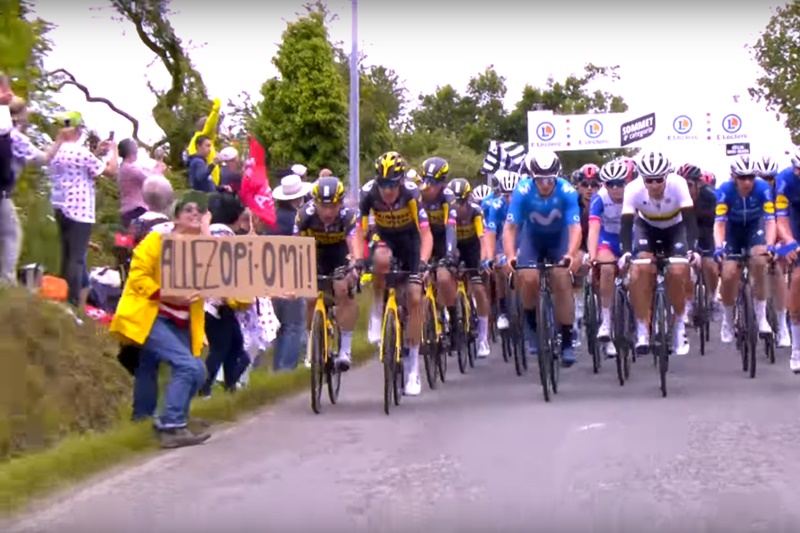
Tony Martin was the unfortunate rider who was allez-opi-omied to the deck, so commencing a veritable domino rally of flesh, sprockets and Lycra.
Crashes and chaos. We come for the racing, but we can’t help but marvel at the absolute frigging madness of it all.
“She made a very bad spatial awareness judgement call,” was Sir Dave Brailsford’s take on it a few days later. Sir Dave’s elite sport speak is clearly now so deeply ingrained that he can no longer talk about things normally.
The racing on Stage 1 was good though. It started on the final climb when Julian Alaphilippe appeared to open his sprint with over 2km to go – a thing that it is very much not possible to do.
But it worked. In fact it worked so well that he’d built up an 8s lead by the line.
The bigger time gaps came from the crashes though (there was also a second, perhaps even bigger crash a bit later on). Miguel Angel Lopez lost 1m49s (as he always does in the first week of a Grand Tour), Richie Porte lost 2m16s, Tao Geoghegan Hart 5m33s and Michael Woods 8m49s.
Any thoughts that Woods’ losses might give his road captain Chris Froome an opportunity to take an almost impossibly unlikely tilt at the yellow jersey were however quashed by the fact the four-time winner lost 14m37s. He finished the week in 153rd place, a mere 1h47m off the race lead.
C’est chic
Stage 2 was noteworthy for being the moment Mathieu van der Poel officially took over from Peter Sagan as the Tour de France’s official freak.
Sagan has had a good run. People still talk about certain stages being Sagan stages. But while he’s still among the strongest riders, it’s pretty obvious that van der Poel is now the person who does the things that make you say ‘bloody hell’.
The Dutchman figured he needed both the stage win and also the time bonus available earlier in the stage to take the yellow jersey – so that’s what he went out and got.
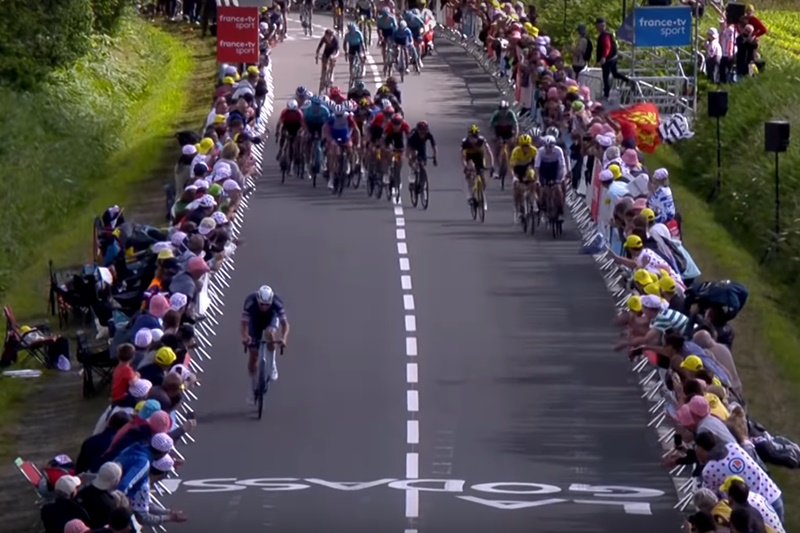
First time up the short, steep Mur de Bretagne, van der Poel rode away from everyone and took the time bonus. Second time up, he rode away from everyone and took the win. These were not the kinds of efforts a human being should be able to do, let alone repeat.
To put the victory effort in context, second and third on the day were Tadej Pogacar and Primoz Roglic – the 2020 Tour winner and runner-up, respectively – and they were six seconds adrift (it was only a three-minute effort). Alaphilippe led a group that was eight seconds back.
Rather worryingly for them, Geraint Thomas and Miguel Angel Lopez were 23 seconds behind. And it would very quickly get a whole lot worse for the Welshman.
Geraint Thomas falls off his bike
After being treated to an unimpeded path throughout Stage 2, Tony Martin’s unexpected obstacle of the day was this time Geraint Thomas, the Welshman having unfurled a trademark needless crash after about 40km.
Undeterred by his shoulder departing its socket, Thomas got it popped back in by a doctor and then carried on. Thomas famously rode 20-and-a-bit stages of the 2013 Tour de France with a broken pelvis after crashing on day one, so he can certainly cope with a spot of excruciating discomfort. It is however worth pointing out that he didn’t win that year. He in fact finished 140th.

Thomas was at least smart enough to get his self sabotage out of the way early. This gave him enough time to catch everyone up again. In contrast, Roglic clipped someone’s wheel and flew out of the peloton sideways with just 10km to go. By this point, the race was on so there was no catching up. He lost about a minute to most of his rivals – even with several other crashes splitting the race further.
The next day the Slovenian required a sufficiently large volume of bandages that he saw fit to refer to himself as The Mummy. “The situation is far from good,” he observed in his wonderfully compulsive deadpan style. By the end of the week, he had abandoned.
Richard Carapaz was the only real overall contender to finish in the front group. Most of the others were 26s back. Miguel Angel Lopez, inevitably, lost another minute.
Only a sprint day
Stage 4 should have been a quiet one that I didn’t have to write about. Flat, featureless, no change in the general classification…
But lo! After five years that took in clinical depression and a years-long virus that removed his ability to contest even smaller races, Mark Cavendish took his 31st stage victory at the Tour de France – in the same town where he took his 26th. This rather foiled my attempts to recap the first week of the Tour de France in under 2,000 words.

Several Britons have won the Tour de France now, but Cav is the nation’s greatest road cyclist. Only Eddy Merckx has more wins in this race and Eddy was not of this world. The Belgian spread his 34 victories over flat days, hilly days, mountain days and time trials. That Cavendish is anywhere close to him from bunch sprints alone is a measure of his absolute peerlessness in that particular field.
This win adds a whole new dimension though. Late last year, Cavendish got in the break in a small Belgian race purely so he could be seen. With wins having become a distant memory, he thought it was his last appearance as a pro. That’s quite a thing to come back from – particularly when you’ve arrived at that point via such protracted deterioration.
It wasn’t like Cavendish had a bad crash and recovered a few months later. He came back from being old and rubbish.
Sprinters don’t tend to endure well. At 35 and with no wins since early 2018, Cavendish’s contract was at an end and he simply wasn’t worth hiring. Deceuninck-QuickStep hired him though and earlier this season, at the Tour of Turkey, he won a race – a mere 1,159 days after he last did so.
A day later, he won again. The day after that, he won a third time.
A stage win at the Tour de France though? That is something else entirely.
Mark Cavendish is something else entirely.
‘The race of truth’
We knew from last year that Tadej Pogacar could do a pretty tidy uphill time trial at the end of a three-week race. A rolling time trial in the first week is a very different thing. Turns out he can do those too.
Afterwards, the Slovenian claimed he’d been looking to limit his losses. Mission accomplished, you’d have to say. He won the stage by 19s, put 44s into the fastest of the other overall contenders (Roglic) and put significantly more time into everyone else.
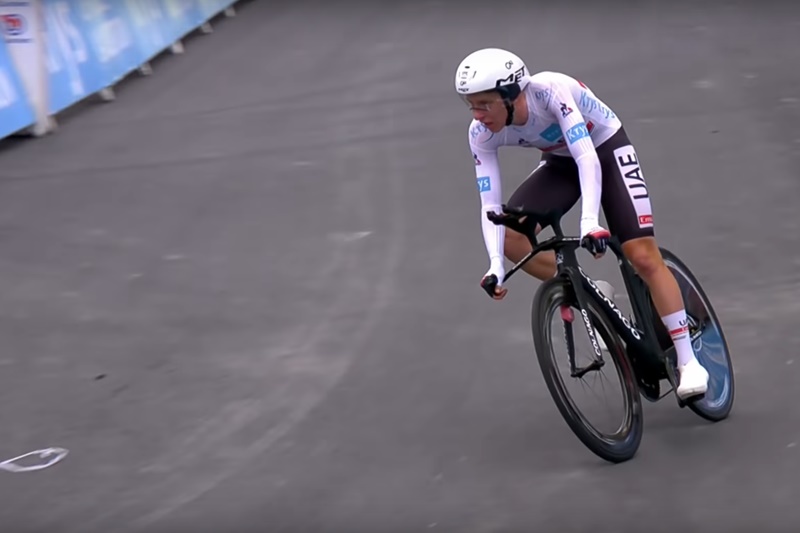
It was the kind of performance that simplified the race considerably. Rather than juggling dozens of names, we’re now left asking one simple question: Will Pogacar’s form hold?
We’ve seen plenty of riders enter Grand Tours ‘hot’ only to fade in the third week. This is definitely a possibility, although his coach, Inigo San Millan, said last month that his powers of recovery are among his greatest strengths.
“While it may take two to three days for others to recover, it may only take Tadej one day,” he said – so maybe the normal rules don’t apply.
32 Tour de France stage victories
Stage 6 brought a second win for Cavendish. Easy sport, innit?
Phantom leaders
Stage 7 was an extremely long (249km), hilly day. A real softener-upper-er with hindsight.
On the face of it, the stage was all about race leader Mathieu van der Poel and well-placed possible-overall-contender Wout van Aert finding their way into the day’s (sizeable) break and the impact that had on the general classification. But as we’ll see in a moment, all of these events turned out to be pretty much irrelevant.

It is, nevertheless, highly unusual to see the yellow jersey in a break. The established contenders clearly concluded van der Poel wouldn’t be able to stay with them on mountain stages. Pogacar’s UAE Team Emirates had a bit of a go at reeling the group back in – probably because of van Aert – but no-one else really helped them.
By the end of the stage, the two opportunists had gained three minutes, but – without wishing to labour the point – it almost certainly won’t matter.
Back in the favourites’ group, Roglic was dropped with 15km to go and lost nine minutes. Team Ineos’s process-of-elimination team leader, Richard Carapaz, attacked a moment later. At one point the Ecuadorian had gained 40 seconds… only for the main group to catch him about six or seven metres from the line.
Pogacar takes the lead
Several things happened in the first 120km of Stage 8, but it was all forgotten when the reigning champion dropped absolutely everyone with 30km to go.
This isn’t a thing that happens. If you’re the favourite, you’re supposed to ride with your rivals until quite near the top, until a point you’re confident everyone’s done for and you can finally display your superiority and maybe gain up to a minute with that last hard effort. Clearly Pogacar took a look around far earlier than that and concluded, “Why wait when it’s so obvious?”
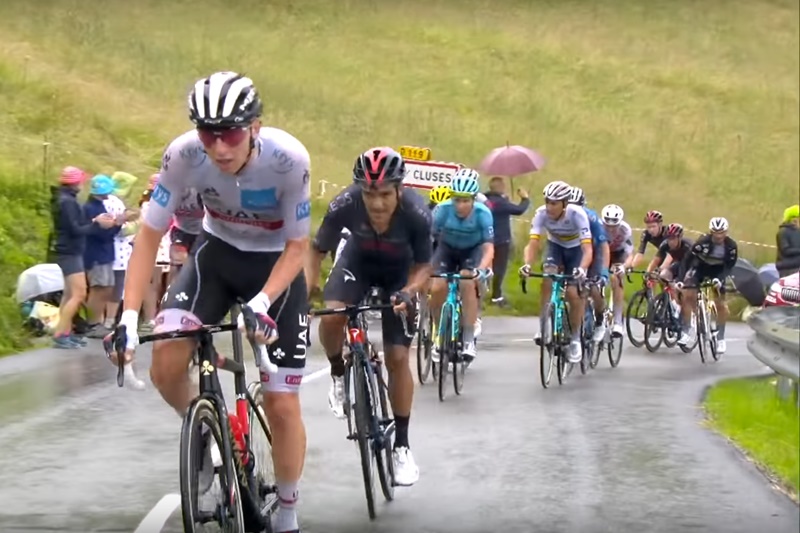
Initially, Carapaz went with him.
No-one else.
“What a duel this is now,” said Ned Boulting on commentary – but it wasn’t. It really wasn’t. Carapaz lasted 400m, at which point Pogacar simply accelerated again. And that was that.
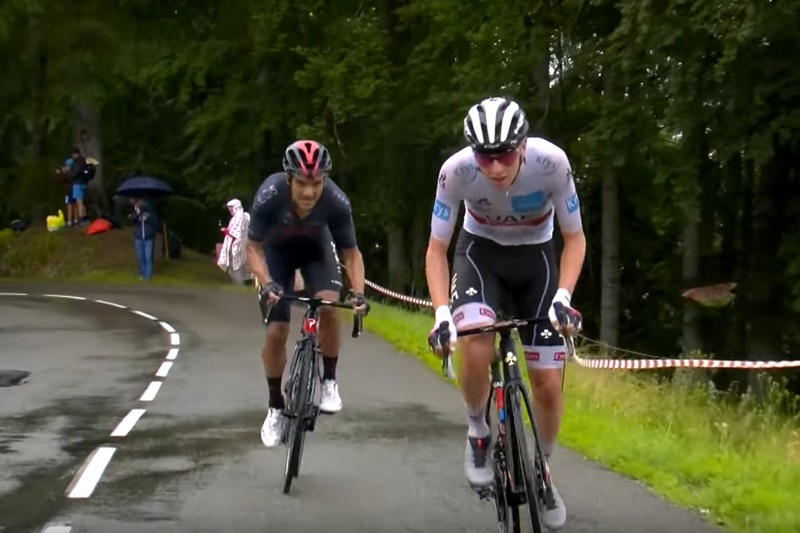
Echoing the previous day, Carapaz was eventually swept back up by the other remaining “contenders,” but they all finished over three minutes behind Pogacar. We were getting towards the end of a seriously hard week. The Slovenian’s ability to recover is perhaps what gave him such a significant edge.
To put the time gap in context, the last time the margin between first and second was that great at the end of the entire Tour de France was in 2016 when Chris Froome bested Romain Bardet by 4m05s after three full weeks of racing.
As I mentioned earlier, Pogacar could theoretically fade in the third week, but on this form he has A LOT of room for deterioration and then a sizeable time buffer as insurance on top of that.
Dessert
Stage 9 was largely characterised by a faint but understandable atmosphere of “what’s the point?” among those racing for the general classification. It ended up a kind of mini version of the day before.
About 4km from the top of the monster 21km final climb to Tignes, the favourites’ group was down to half a dozen riders. Carapaz attacked, Pogacar followed. Then, after a momentary lull, the yellow jersey decided this was the moment to gradually accelerate, eyeballing Carapaz as he did so to gauge the exact level of power needed to wave bye-bye to everyone today. The Ineos man dropped his head and didn’t even bother trying.

This time the damage was a mere 32 seconds.
Australian rider Ben O’Connor won the stage after being in the break and moved into second overall. That did at least mean that someone was within five minutes of Pogacar.
I mean just look at the state of the overall standings.
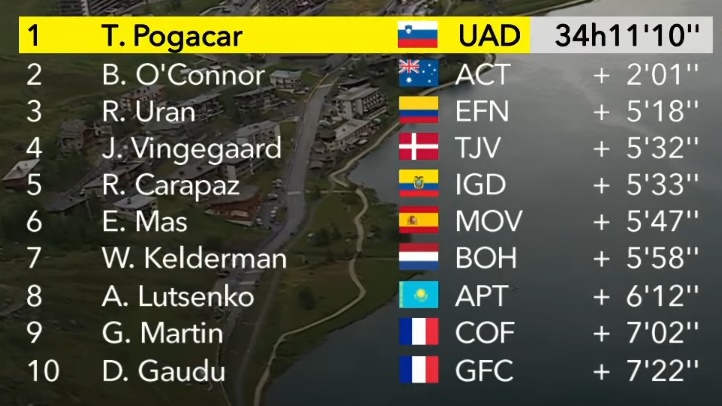
What’s next?
I’ll be back this time next week with a recap of the second week. This will be shorter because (a) there are only six stages this week, not nine, and (b) there’s a greatly reduced likelihood of significant events taking place.
It’s the Tour de France though, so pretty sure there’ll be something nuts. You can sign up to get these recaps by email here. Please spread the word.
Leave a Reply